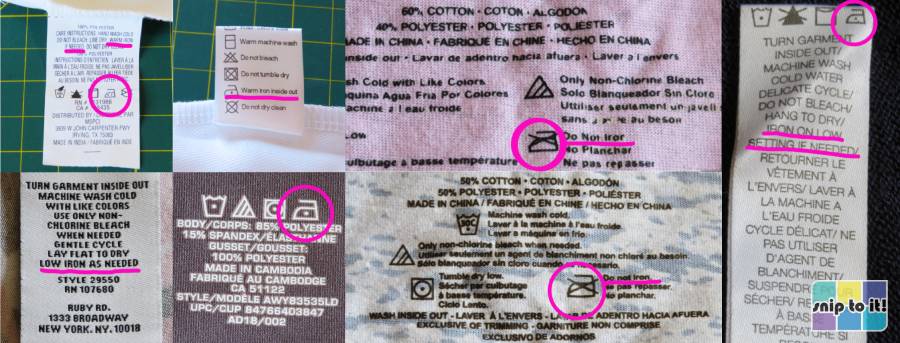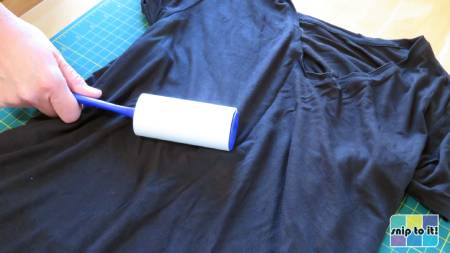Iron-on/heat transfer vinyl (HTV) is wonderfully versatile and can be used to decorate everything from T-shirts to cardstock. But using heat to apply vinyl to fabric requires care and attention to both the HTV and the textile you are using.
I learned the hard way after scorching a delicate rayon/spandex T-shirt that I was personalizing for my mother in-law!
To help you avoid making the same mistakes as I did, I have compiled some tips for heat pressing HTV on polyester and synthetic/blend fabrics. I will cover the basics of how to choose heat press time and temperature, and how to use heat applications on fabrics that can potentially melt, discolor, and scorch.
1. HTV on polyester temperature and time settings depend on 2 key factors
There are 2 main things you have to consider when choosing time and temp settings for your project:
- the fabric you are pressing on
- the specific brand and type of HTV you are using
The first big takeaway is that the pressing guidelines for your fabric may be at odds with those of your HTV. You may have to use trial and error to determine a middle ground that lets the HTV adhere properly but doesn’t damage the fabric with too much heat.
2. How heat-sensitive is your fabric? Check the laundry care label before you start
The first thing to do is check the laundry care label on your fabric item. The ironing instructions will be the key to determining how you should apply your HTV. The instructions might just be a symbol, written text or both.
These labels are probably familiar to most of you (even if you’re like me and mainly ignore them). It is crucial that you treat these fabrics differently than a regular cotton shirt when pressing your HTV.

There are many different synthetic and blended fabrics beyond polyester that can be heat sensitive, including:
- spandex/lycra/elastane
- acetate
- acrylic
- microfibre
- nylon
- rayon/viscose (not synthetic, made from plants like bamboo, but often blended with synthetics)
- modal (not synthetic, made from beech tree fiber, but often blended with synthetics)
What do the ironing instruction symbols mean?
Depending on the composition of your fabric, you may have to set your heat press temperature much lower than normal.

According to GINETEX, the International Association for Textile Care Labelling, it is more important to pay attention to the dots on the label than to the fiber composition.
- No dots (Do not iron) = According to GINETEX, “Irreversible changes must be expected if an iron is used.” In other words, give very careful consideration before applying HTV to these items!
- One Dot ( • ) = Iron at maximum temperature of 230oF/110oC
- Two Dots ( • • ) = Iron at maximum temperature of 302oF/150oC
- Three Dots ( • • • ) = Iron at maximum temperature of 392oF/200oC
In general, if your polyester item’s label says iron on medium or high setting, use the HTV manufacturer’s normal recommended time and temperature settings. However, if your fabric’s label says do not iron or iron low temp, you will likely have to apply your HTV below the usual recommended temperature.
3. You can compensate for lower heat with longer dwell time
If you reduce your heat press temperature, prepare to press your HTV for longer than normally recommended by the manufacturer.
For example, if you want to press regular Siser Easyweed on a heat-sensitive polyester garment, set your heat press at 270-280oF. Press for 15-20 seconds instead of the usual 10-15 seconds at 305oF.
Every HTV and fabric combination will be different. Test how your vinyl and your fabric perform at the lowered temperature and the extended time you choose.
4. Choose the right kind of HTV for polyester
You should always check the manufacturer’s guidelines before applying HTV. All major brands of HTV include recommended time and temperature settings, and many include specific instructions for different fabrics.
Siser, Cricut, Specialty Materials (Thermoflex), Stahls, and StarCraft all indicate which types of their HTV can be applied to specific fabrics. Not all HTV is compatible with every fabric!
5. When applying Siser HTV on heat-sensitive polyester, start at 270-280oF
Siser HTV is extremely versatile:
- all HTV types except EasyWeed Sub Block (polyester only) list compatibity with polyester, poly/cotton blends, and cotton
- EasyWeed Stretch can apply to lycra/spandex
- EasyWeed Extra and EasyReflective can also apply to nylon
Siser recommends that you lower your heat press temperature to 280oF as the starting point for using their HTV with sensitive fabrics. You may find 270-280oF too high to press on “do not iron” and “iron on low setting” fabrics. In that case, you will have to test your HTV at lower temperatures. Also test your fabric to see if it can withstand higher temperatures than recommended.
Using a Cricut Easy Press to apply Siser HTV on polyester
In our guide to using an EasyPress to apply Siser HTV, we recommend pressing at a higher temperature than usual. This recommendation is fine for cotton garments or other fabrics that are labelled Iron on Medium or High on their washing care instruction tag.
But, if you are pressing polyester labeled Iron on Low, be cautious and skip the increased temp recommendation. You can find our standard time and temperature guide for Siser HTV here.
We tested Siser Easyweed and Sparkle on polyester labeled Iron on Low with an EasyPress2 at the original Siser-recommended settings (305oF, 10–15 seconds). We had no trouble getting the HTV to stick without damaging the fabric.
6. Cricut HTV types can apply to a surprising array of polyester and other synthetic fabrics
Cricut has an interactive heat guide that gives time and temp settings based on your HTV and base material. We created printable, at-a-glance versions of the heat guide for pressing with your EasyPress and EasyPress Mini.
Cricut makes HTV types that will adhere to a wide number of synthetic fabrics, including nylon:
- all Cricut Iron-On is compatible with neoprene
- Everything is compatible with polyester except Iron-On Designs, Patterned Iron-On, and Smart Patterned Iron-On
- Compatible with nylon: Everyday Iron-On/Lite/Metallic, Iron-On Mesh, Foil, Sportflex, and Smart Iron-On
- Compatible with mesh: Everyday Iron-On/Lite/Metallic, Iron-On Mesh, Express Iron-On, Foil, Smart Iron-On, Smart Holographic
- Sportflex Iron-On is only compatible with nylon, polyester, and neoprene fabrics, no natural fibers
The basic instruction for applying Cricut HTV to polyester with an EasyPress is to press for 30 seconds, then flip the garment and press on the reverse side for another 15 seconds.
Do you have a heat-sensitive item with a recommended press temperature that falls below Cricut’s recommendation? Do a test press at a lower temperature to see how your fabric and the iron on material perform.
7. Not all HTV is compatible with Nylon or Nylon coated fabric (like HTV on polyester jackets)

Another popular polyester item for decorators is jackets. Popular styles of jackets like windbreakers, and warmups often have a waterproof coating or they are a nylon/polyester blend.
Nylon requires special consideration when you’re applying HTV. It does have a low melt point, and its porous nature makes it difficult to apply conventional adhesives.
But there is HTV made just for nylon application. Siser Extra or ThermoFlex Xtra have extra strong adhesives made just for bonding onto nylon and (some) coated synthetics. As mentioned above, most types of Cricut Iron-On are rated for nylon as well.
8. Before you start, test press your fabric first!
Fabric designated with low- or no-heat setting may discolor when heat is applied, so be cautious before applying your HTV. Do a test press on the corner, back or inside of the fabric – somewhere where a small scorch or discoloration will not be seen.
(Ideally it would be best to have a duplicate of your blank so you can do a heat press test on one and have a spare in case the heat is too high.)
- Set your heat press to the lowest temperature you determined based on your fabric and HTV
- Press for 5-10 seconds
- If your fabric retains its color and texture, you should be good to press at that temperature
9. Test-press dyed polyester and use specialty HTV for sublimated fabric
If you have a heavily dyed fabric as your base material, you also want to do a test press to see if the dye is discolored or otherwise marred during heat application.
Sublimation ink in particular can be re-activated with heat – check your garment! If the dye is only on the outside, it’s likely your material was decorated using sublimation. Be careful when applying HTV, and consider using HTV made to resist taking up sublimation ink like Siser’s Sub Block HTV or Specialty Materials Thermoflex Subliblock Turbo.
9. Do a test press of your HTV
Before you start pressing your project, it’s a good idea to do a test press of your vinyl. If you only have one blank item for the project, you may want to skip this step, but if you have one to spare for practice, it’s a good idea to press a small sample piece of your HTV to see how it sticks with lower temperature.
It’s also a good idea to try test pressing the vinyl in layers to get an idea of how many total seconds you need to press to get a good bond.
10. Should you pre-wash your blank or not? Prepare your fabric for the best HTV application
You don’t need to pre-wash your blank, and you definitely don’t want to pre-wash if you’re making items to sell. If you’re applying HTV to polyester items like bags, accessories, flags, etc. you probably won’t ever be laundering those items anyway.

When I decorate shirts for myself, friends and family, I do pre-wash them. If you choose to pre-wash your blank, the only thing to remember is NEVER use liquid fabric softener! This will leave residue on your fabric that will prevent the HTV from getting a good bond with the fabric.
No matter what you choose, pre-wash or not, always remember to use a lint roller to clean any fuzz or hair off your fabric before you press. This is especially true if you’ve got furry friends at home who love to hang out in your workspace.
11. Pre-press to remove wrinkles and moisture
Once you have set your press to the correct temperature for your garment and done a test press, you should be ready to start pressing the HTV onto the fabric. Before you apply the vinyl, make sure to pre-heat your garment on the heat press for a few seconds to smooth out the wrinkles and remove any moisture.
12. Use a cover sheet when pressing
When you have your garment ready and your HTV in place, make sure you use a cover sheet when you press. Whether you are using a teflon sheet, parchment paper or cloth, you will be adding a layer of protection for your fabric.
Select a cover sheet that’s not too thick, as a heavy sheet (e.g. silicone) may diffuse too much heat and prevent your HTV from sticking, while also holding heat longer than a light cover like parchment.
If you’re pressing on sublimated polyester, use a paper cover sheet (copy/kraft/butcher paper etc.) and do NOT reuse it!
(A cover sheet will also protect your heat press from adhesive and/or dye bleeds. Using one every time you press is a good idea, no matter what you are pressing)
13. Be aware of different temperature settings for each type of vinyl when layering HTV on Polyester
When you are applying multiple layers of HTV onto polyester, it’s important to keep track of the different temperature requirements of different HTV.
For example, I recently participated in Heat Transfer Warehouse’s latest “favorite TV/movie” themed decoration challenge. The instructions said to use at least 3 different types of HTV on a polyester cinch backpack. I created a multilayered design based on a photo with a light tone, mid-tone and dark tone layer.
I cut the light and mid-tone layer out of Siser Easyweed, and the dark-tone layer out of WALAKut Express. Because my blank was OK to press at warm temperatures, I used the recommended setting provided by the manufacturers:
- Siser Easyweed: 305oF for 10-15 seconds
- WALAKut Express: 290oF for 5-10 seconds
Related: How to make a 3D layered decal out of flocked HTV
14. The key to layering HTV is pressing in short increments

Over-pressing can damage fabric and HTV, and can reduce the stickiness of your vinyl by cooking the adhesive.
Layering the HTV for my Heat Transfer Warehouse project, I pressed the bottom layer (EasyWeed) for 2 seconds, peeled the carrier then pressed the second layer (also Easyweed) for another 2 seconds. I then reduced my Cricut EasyPress temperature from 305 to 290oF and pressed the top layer for 5 seconds. That gave me a total press time that was within the recommended range for all three layers.
- Layer #1 (Easyweed Lime): 3 presses/9 total seconds
- #2 (Easyweed Sky Blue): 2 presses/7 total seconds
- #3 (WALAKut Express Black): 1 press/5 total seconds
Video: How to Layer HTV on Polyester
If you want to see the entire project from layout in Cricut Design Space to the finished project, I’ve made a video that will show you every step in detail.
15. Use low temperature HTV for very heat sensitive fabrics
For very heat-sensitive fabrics, I urge you to take a lot of precautions before pressing. Always have a spare blank or fabric swatch on hand to test how the fabric reacts to different heat settings. You also want to know how the HTV presses at reduced temperatures.
If your base material is one-of-a-kind, an heirloom or has some other special significance to you, I urge you to take seriously the warning that ANY heat could cause irreversible changes to the fabric.
It’s important to note here that I haven’t found any HTV that has an application temperature below 230oF (the recommended maximum iron temperature for low iron setting fabrics). Applying HTV on delicate items marked “no iron” or “low iron setting” will have to be done above the recommended ironing temperature on the tag.
If you are comfortable experimenting with HTV on “do not iron” or “iron on low setting” fabrics, here are 3 product options that have low application temperatures and short press times:
Low temperature HTV options:
- WALAKut Express: Temp range 250oF–302oF for 5 seconds (16 colors) – I used black WALAKut Express for my project
- Also available in Neon (3 colors)
- Thermoflex Turbo Low Temp: 270oF for 5 seconds (25 colors)
- Xpress Cut HTV from Coastal Business: 250oF for 5 seconds (19 colors)

Final thoughts
Applying HTV to polyester or other synthetic fabrics doesn’t have to be intimidating if you are prepared before you start pressing.
Start by checking how heat sensitive your fabric is, and adjust your heat press temperature and press time accordingly. Sensitive fabrics need to be pressed at a lower temperature for a longer period, and it’s very important to test press your fabric before you begin applying HTV. (If you can manage it, try to get a spare blank in case you scorch or discolor your fabric with too much heat)
Once you’ve started applying your HTV, use a cover sheet to help protect your fabric. Apply layered or overlapping sections of HTV in short increments and keep track of the cumulative time.
Once you understand your polyester fabric and its relationship to heat, you should be able to press HTV with confidence and get great results.
Image credits:
Jacket photo credit: OfficialC5/Wikimedia Commons